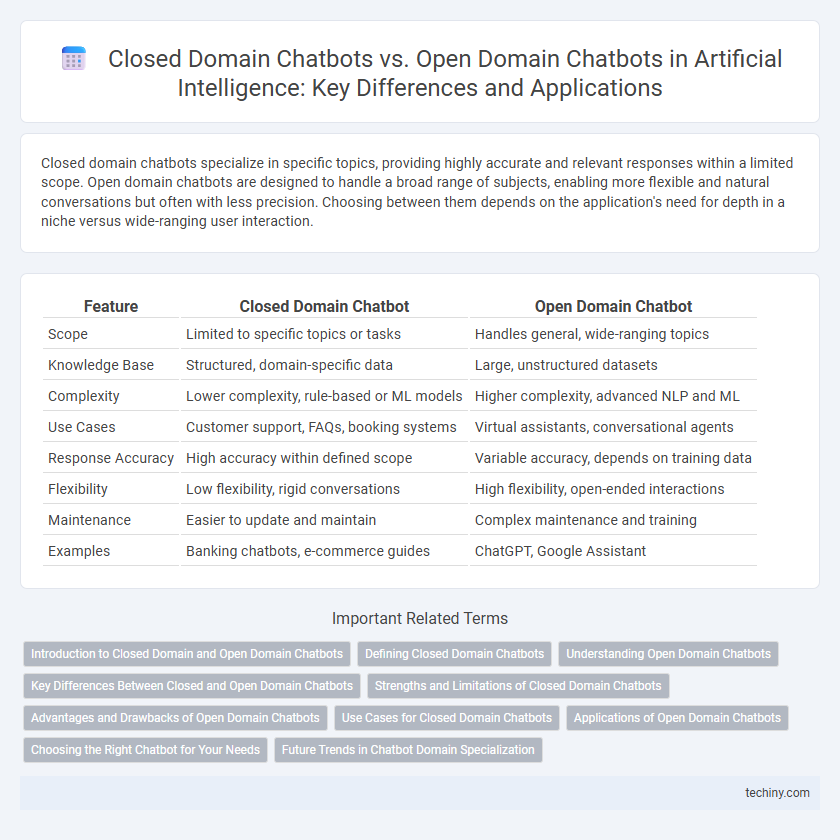Closed domain chatbots specialize in specific topics, providing highly accurate and relevant responses within a limited scope. Open domain chatbots are designed to handle a broad range of subjects, enabling more flexible and natural conversations but often with less precision. Choosing between them depends on the application's need for depth in a niche versus wide-ranging user interaction.
Table of Comparison
| Feature | Closed Domain Chatbot | Open Domain Chatbot |
|---|---|---|
| Scope | Limited to specific topics or tasks | Handles general, wide-ranging topics |
| Knowledge Base | Structured, domain-specific data | Large, unstructured datasets |
| Complexity | Lower complexity, rule-based or ML models | Higher complexity, advanced NLP and ML |
| Use Cases | Customer support, FAQs, booking systems | Virtual assistants, conversational agents |
| Response Accuracy | High accuracy within defined scope | Variable accuracy, depends on training data |
| Flexibility | Low flexibility, rigid conversations | High flexibility, open-ended interactions |
| Maintenance | Easier to update and maintain | Complex maintenance and training |
| Examples | Banking chatbots, e-commerce guides | ChatGPT, Google Assistant |
Introduction to Closed Domain and Open Domain Chatbots
Closed domain chatbots specialize in specific topics or tasks, offering highly accurate and context-aware responses within predefined boundaries. Open domain chatbots handle a wide range of subjects and engage in free-form conversations, powered by advanced natural language processing and large-scale language models. The choice between closed and open domain chatbots hinges on the application's complexity, user intent diversity, and required response precision.
Defining Closed Domain Chatbots
Closed domain chatbots are specialized AI systems designed to handle specific topics or tasks within a limited scope, such as customer support for a particular product or service. These chatbots utilize domain-specific knowledge bases and predefined rules to deliver precise and relevant responses. Their performance excels in environments where accuracy and consistency are critical, but they lack the flexibility to engage in open-ended conversations beyond their designated domain.
Understanding Open Domain Chatbots
Open domain chatbots leverage advanced natural language processing and deep learning models to handle vast topics, enabling dynamic, context-aware conversations with users. These AI systems continuously learn from diverse datasets, improving their ability to interpret and generate human-like responses across various industries such as customer service, healthcare, and entertainment. Unlike closed domain chatbots, open domain models require extensive training on large-scale corpora to maintain relevance and accuracy in unpredictable dialogues.
Key Differences Between Closed and Open Domain Chatbots
Closed domain chatbots excel in handling specific tasks within a limited scope, offering precise and accurate responses by leveraging curated datasets and rule-based algorithms. Open domain chatbots utilize advanced natural language processing and machine learning techniques to engage in wide-ranging conversations, managing diverse topics with flexible, context-aware interactions. The key differences lie in their scope, conversational depth, and adaptability, with closed domain bots prioritizing accuracy in specialized areas and open domain bots emphasizing broad understanding and dynamic dialogue generation.
Strengths and Limitations of Closed Domain Chatbots
Closed domain chatbots excel in providing accurate and relevant responses within specific topics due to their focused training on limited datasets, ensuring high reliability and consistency in tasks like customer support or technical assistance. Their limitation lies in the inability to handle queries outside their predefined scope, often resulting in failure to understand or respond to unexpected questions. These chatbots require less computational power and have faster response times compared to open domain counterparts, making them ideal for specialized applications.
Advantages and Drawbacks of Open Domain Chatbots
Open domain chatbots excel in handling a wide range of topics and natural language inputs, enabling more flexible and versatile user interactions across various subjects. Their main drawback is increased complexity in understanding context, leading to occasional irrelevant or ambiguous responses compared to closed domain chatbots tailored for specific tasks. Training open domain chatbots requires vast datasets and advanced NLP models like GPT or BERT, posing significant computational demands and potential biases.
Use Cases for Closed Domain Chatbots
Closed domain chatbots excel in providing specialized assistance within specific industries such as healthcare, finance, and customer support by delivering accurate and context-aware responses. These chatbots handle tasks like booking appointments, processing transactions, and troubleshooting product issues with high precision due to their limited scope. Their ability to access and interpret structured data from internal databases enhances user experience by streamlining interaction workflows and increasing efficiency.
Applications of Open Domain Chatbots
Open domain chatbots, such as GPT-4 and ChatGPT, are extensively used in customer service, virtual assistants, and content generation due to their ability to handle diverse topics without predefined constraints. Their applications span industries including healthcare for patient interaction, education for personalized tutoring, and entertainment through interactive storytelling. By leveraging advanced natural language understanding and generation, open domain chatbots enhance user engagement and provide flexible, real-time conversational experiences.
Choosing the Right Chatbot for Your Needs
Choosing the right chatbot depends on your specific requirements and use cases. Closed domain chatbots excel in handling specialized tasks with high accuracy by focusing on a limited range of topics, making them ideal for industries like healthcare, finance, or customer support. Open domain chatbots offer broader conversational abilities suited for general inquiries and casual interactions but may lack precision in specialized contexts.
Future Trends in Chatbot Domain Specialization
Closed domain chatbots specialize in specific industries such as healthcare or finance, leveraging tailored datasets and domain-specific language models to deliver highly accurate and context-aware interactions. Open domain chatbots utilize large-scale transformer architectures like GPT to handle diverse topics but face challenges in maintaining depth and precision across all subjects. Future trends indicate hybrid models combining domain-specialization with adaptable open-domain capabilities, driven by advances in few-shot learning and continuous domain adaptation techniques to enhance both relevance and conversational versatility.
Closed Domain Chatbot vs Open Domain Chatbot Infographic

 techiny.com
techiny.com